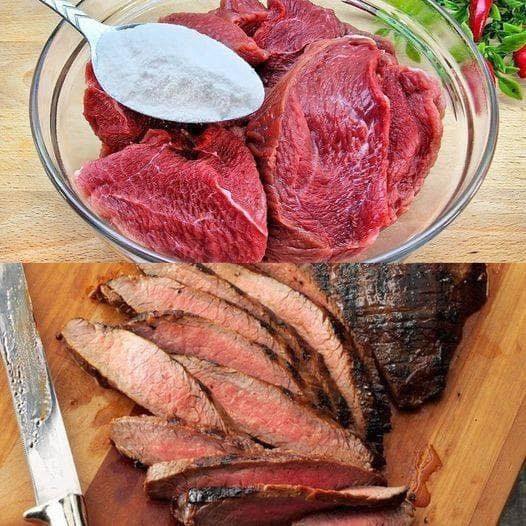ADVERTISEMENT
#### **Step-by-Step Instructions:**
**1. Prepare the Beef**
– Start by slicing the beef thinly against the grain into bite-sized pieces. Thin slices ensure that the velveting technique works more effectively, allowing the coating to cling to the beef better.
– For extra tenderness, you can even give the beef a light pound with a meat mallet to break down the fibers slightly. This step is optional but can make a big difference in the texture.
**2. Make the Velveting Marinade**
– In a bowl, whisk together the egg white, cornstarch, soy sauce, rice wine (if using), sesame oil, and salt. This mixture will coat the beef and create that velvety texture.
– Add the beef to the marinade and mix it well, ensuring that each piece is thoroughly coated. You should let the beef marinate for at least 30 minutes to an hour for the best results. If you have the time, marinating the beef for longer will deepen the flavor and enhance tenderness even further.
**3. Velvet the Beef (Blanching)**
– After marinating, it’s time to velvet the beef. There are two common methods for this: **blanching in water** or **blanching in oil**.
– **Blanching in Water**: Bring a pot of water to a boil (just enough to submerge the beef), then reduce the heat to medium-high. Add the beef pieces to the water in small batches. Let them cook for about 1-2 minutes, or until the beef changes color and floats to the surface. Once the beef is ready, remove it from the water and set it aside to drain.
– **Blanching in Oil**: Alternatively, heat a wok or pan with enough oil to cover the beef. Once the oil is hot (but not smoking), gently add the beef and stir it around for about 1-2 minutes, just until the beef is browned and cooked through. Remove it and drain on paper towels.
**4. Stir-Fry and Finish the Dish**
– Now that your beef is velvety and tender, you can proceed with your stir-fry or any other recipe. Heat a small amount of oil in a pan, and stir-fry your favorite vegetables or aromatics (like garlic, ginger, onions, and bell peppers). Then, add the velveted beef and toss it in the wok or skillet for a few minutes until it’s well combined with the vegetables and the sauce.
### **Tips for Perfect Velveting Every Time**
– **Use the Right Cut of Beef**: While you can use many cuts, lean cuts like flank steak, sirloin, or tenderloin are ideal for velveting. They hold up well and provide the tender texture you’re looking for.
– **Don’t Overcook**: One of the biggest mistakes people make when using the velveting technique is overcooking the beef. The purpose of velveting is to tenderize the beef without cooking it too much in the blanching process. Once it’s done, you just need a quick stir-fry to finish the dish.
– **Practice Patience**: Let the beef marinate for the recommended amount of time. This allows the cornstarch and egg white to bind properly to the meat and helps lock in the moisture. Patience will lead to better results!
– **Velvet Other Proteins**: This technique isn’t limited to beef. You can velvet chicken, pork, shrimp, and even tofu using the same marinade and method. It’s a versatile technique that ensures tender meat in all your favorite stir-fry dishes.
### **Why This Chinese Technique Works So Well**
The beauty of **velveting beef** is that it’s an incredibly simple and effective way to achieve tender, flavorful meat without the need for a long cooking time or expensive cuts of beef. It works by preventing the beef from becoming overcooked or dry, which can often happen with traditional stir-fry methods. Instead, the beef is cooked just right, maintaining moisture and tenderness in every bite.
### **Conclusion: The Secret to Tender, Restaurant-Quality Beef**
Now that you know the **Chinese secret to tenderizing beef**, it’s time to start experimenting in your own kitchen. Whether you’re cooking a stir-fry, beef and broccoli, or any other Chinese-inspired dish, using the velveting technique will elevate your cooking and provide that perfect, melt-in-your-mouth beef every time.
The best part? It’s easy to master, and with just a few simple ingredients, you can unlock a whole new world of flavor and texture in your cooking. So, the next time you want to impress your family or guests with restaurant-quality beef, remember this ancient Chinese technique and let your dishes shine!
ADVERTISEMENT
